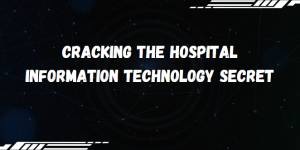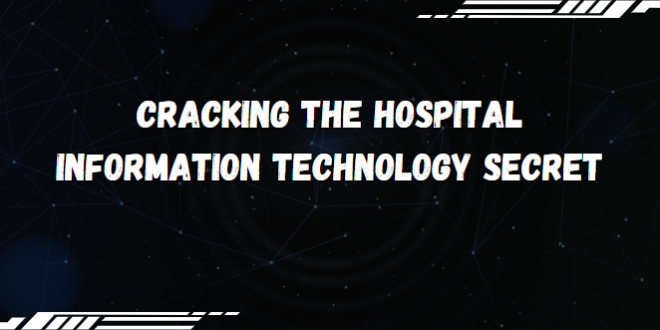Hospital information technology (HIT) plays a crucial role in modern healthcare systems. It encompasses the use of technology and digital systems to manage patient information, streamline operations, improve patient care, and enhance overall efficiency in hospitals. In this article, we will delve into the world of hospital information technology and uncover its secrets.
1. Managing Patient Information
One of the key functions of hospital information technology is to manage patient information effectively. This includes storing, organizing, and retrieving patient records, medical history, test results, and other relevant data. HIT systems provide a centralized platform for healthcare professionals to access accurate and up-to-date patient information.
2. Enhancing Communication and Collaboration
Hospital information technology facilitates seamless communication and collaboration among healthcare professionals. It allows doctors, nurses, and other staff members to share information, discuss patient cases, and coordinate care more efficiently. This promotes interdisciplinary teamwork and improves patient outcomes.
3. Streamlining Administrative Tasks
HIT systems automate various administrative tasks in hospitals, such as appointment scheduling, billing, and inventory management. By streamlining these processes, hospitals can reduce paperwork, minimize errors, and optimize resource utilization. This frees up staff time, allowing them to focus on providing quality patient care.
4. Improving Clinical Decision-Making
Hospital information technology provides healthcare professionals with access to clinical decision support tools. These tools analyze patient data and medical literature to offer evidence-based recommendations and alerts. By leveraging HIT systems, doctors can make more informed and accurate clinical decisions, leading to improved patient safety and outcomes.
5. Enhancing Patient Engagement
Hospital information technology empowers patients to actively participate in their own care. Patient portals and mobile applications allow individuals to access their medical records, schedule appointments, communicate with healthcare providers, and receive educational resources. This fosters a collaborative patient-provider relationship and promotes better health management.

6. Ensuring Data Security and Privacy
Hospital information technology prioritizes data security and privacy. Robust security measures, such as encryption, user authentication, and audit trails, are implemented to protect patient information from unauthorized access or breaches. Compliance with privacy regulations, such as the Health Insurance Portability and Accountability Act (HIPAA), is crucial in maintaining patient trust.
7. Supporting Research and Analytics
HIT systems serve as valuable sources of data for research and analytics purposes. Aggregated and anonymized patient data can be analyzed to identify trends, patterns, and insights that contribute to medical research, population health management, and quality improvement initiatives. This data-driven approach helps hospitals make data-backed decisions and drive innovation.
8. Integrating Systems and Devices
Hospital information technology plays a pivotal role in integrating various systems and medical devices. Electronic health record (EHR) systems, laboratory information systems, radiology systems, and other healthcare technologies are interconnected to ensure seamless data flow and interoperability. This integration enhances care coordination and reduces duplication of tests and procedures.
9. Facilitating Telemedicine and Remote Care
With the advancements in hospital information technology, telemedicine and remote care have become increasingly accessible. Patients can connect with healthcare providers remotely, receive virtual consultations, and monitor their health through wearable devices. This improves access to care, especially for individuals in remote areas or with limited mobility.
10. Continuous System Optimization
Hospital information technology is a constantly evolving field. Healthcare organizations continually optimize their HIT systems to adapt to changing needs, technological advancements, and regulatory requirements. Regular system upgrades, training programs, and user feedback ensure that hospitals maximize the benefits of their HIT investments.
In Conclusion
Hospital information technology is a powerful tool that revolutionizes the way healthcare is delivered. From managing patient information and enhancing communication to streamlining administrative tasks and supporting research, HIT systems have the potential to transform the healthcare landscape. By embracing and harnessing the secrets of hospital information technology, hospitals can provide better care, improve patient outcomes, and pave the way for a more efficient and patient-centered healthcare system.
Until We Meet Again
Thank you for joining us on this exploration of hospital information technology. We hope this article has provided valuable insights into the importance and benefits of HIT systems in modern healthcare. Stay tuned for more captivating articles where we uncover the secrets and innovations that shape the world of healthcare. See you soon!
 Spacetimes A collection of the latest news and information from various trusted sources
Spacetimes A collection of the latest news and information from various trusted sources
